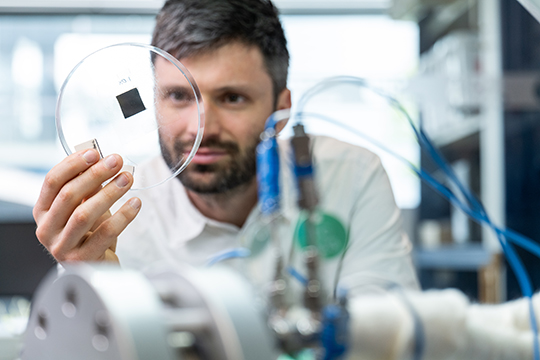Green Hydrogen
Freiburg, Jun 02, 2021
The chemical process of generating hydrogen releases carbon dioxide. This is precisely what Dr. Severin Vierrath of the University of Freiburg’s Department of Microsystems Engineering (IMTEK) wants to avoid. He is investigating “green” hydrogen as an energy source of tomorrow. Two of his projects have simultaneously won awards in a nationwide German ideas competition.

Severin Vierrath wants to avoid releasing carbon dioxide when isolating hydrogen. His research, therefore, revolves around applying regenerative energies to the production of what has come to be known as green hydrogen Photo: Klaus Polkowski
Germany’s Federal Ministry for Economic Affairs and Energy calls hydrogen “a key to the energy transition,” while two years ago, the Federal Ministry of Education and Research (BMBF), proclaimed the “Hydrogen Republic of Germany.” The title marked the start of an ideas competition that has in the meantime concluded its first round. Sixteen projects are receiving at total of 56 million euros in support. The BMBF has chosen three of these to highlight expressly and separately on its homepage. IMTEK’s Dr. Severin Vierrath says this focus is “because to a great extent they make clear what hydrogen can do in future.”
Two of the three projects are Vierrath’s, who leads the Electrochemical Energy Systems Group. Vierrath is pursuing applied basic research – which also addresses marketability – in both cases. “Industry is also taking part in our projects,” he says, namely, with their own financial engagement. Vierrath adds, “Companies only do that when they definitively see application possibilities.” He has been researching hydrogen since 2012. Looking back to right at the start, he recalls the more or less skeptical initial reception from industry. That’s why Vierrath is doubly pleased that the BMBF has spotlighted his projects. “Together with Asia and the US, we’re at the forefront of hydrogen research. We need to ensure that later on, when it comes to market applications of this technology, that we’ll still be there,” he says.
Isolating with regenerative energies
Isolating hydrogen is a complex chemical process. For a long time, fossil fuels were used to provide the energy required, and released carbon dioxide (CO2) during the process. “Of course, that’s precisely what we want to avoid,” says Vierrath, because reducing CO2 emissions is one of the most pressing problems of our time. His research, therefore, revolves around applying regenerative energies to the production of what has come to be known as green hydrogen. “Loosely speaking, there are two processes at the moment,” Vierrath explains. “One of them is very costly,” he continues, “the other is less expensive, but also less effective. We’re working on integrating the advantages of both methods.”
Up until now, electrolysis – the process of splitting water into hydrogen and oxygen – was carried out by means of a membrane coated with iridium, a rare and very expensive precious metal in the platinum group. The process investigated by the researchers at Freiburg works without iridium. Instead, electrolysis takes place via what is known as an anion exchange membrane (AEM). This method could lower the costs of producing green hydrogen significantly in future. Vierrath calls the project “AEMready.”
Long-life fuel cells
Fuel cells are needed in order to ultimately use the green hydrogen that’s been produced. These first use the hydrogen to generate electricity to e.g. drive an electric vehicle. This is where Vierrath’s second research project, “Coral HD,” comes in. The aim of “Coral HD” is developing materials for particularly long-life fuel cell electrodes that will last far longer than 30 thousand operating hours. In this effort, Vierrath is working together with Prof. Anna Fischer of the Institute of Inorganic and Analytical Chemistry of the University of Freiburg and the cluster of excellence, Living, Adaptive and Energy-autonomous Materials Systems (livMatS). She is an expert on the application of nanomaterials and catalysts for the electrochemical conversion and storage of energy.
Both projects are taking place in cooperation with other institutes. Vierrath says, “Coral HD is even an all-Freiburg cluster.” Among those taking part are the Fraunhofer Institute for Solar Energy Systems ISE and the non-profit microsystem engineering research association, Hahn Schickard, both of Freiburg. In order to promote sharing and cooperation within the alliance, Vierrath has introduced a regular meeting that he calls the “Hydrogen Lunch.” The researcher says, “Of course, pandemic conditions meant there were virtual meetings, each of which was linked to a keynote speech.” International experts were able to join in as speakers because no travel was required for the lectures.
Vierrath says the hydrogen projects are making good progress. He sees the applications for fuel cells in aviation, maritime, rail, and automobile transport. “They’re too expensive for individual transport,” he says. Nevertheless, the Freiburg researcher is convinced that battery technology could make such enormous progress in the coming years it would be unimaginable today.
Mathias Heybrock
The Hydrogen Republic of Germany – An Ideas Competition (in German)

